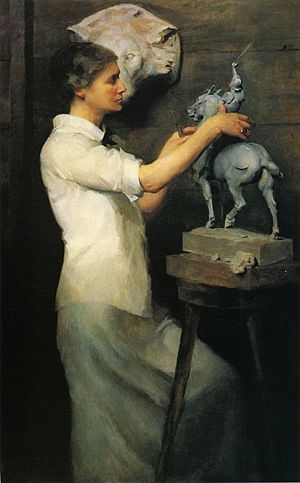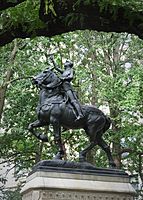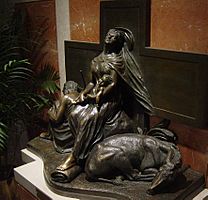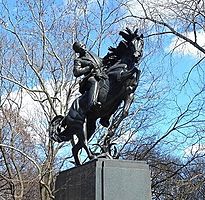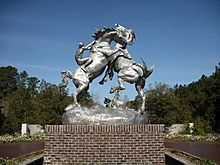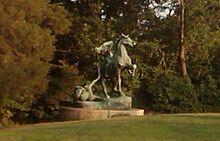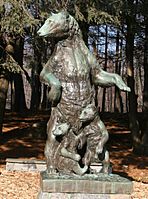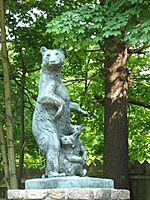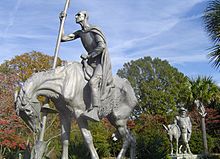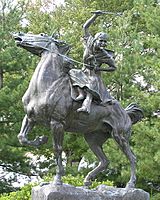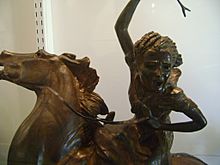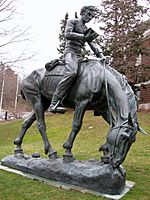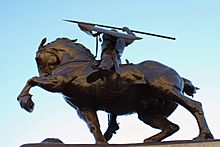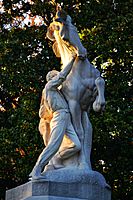Anna Hyatt Huntington facts for kids
Quick facts for kids
Anna Hyatt Huntington
|
|
|---|---|

Anna Hyatt Huntington in 1921
|
|
| Born |
Anna Vaughn Hyatt
March 10, 1876 |
| Died | October 4, 1973 (aged 97) |
| Nationality | American |
| Education | Art Students League of New York |
| Known for | Sculpture |
| Awards | Chevalier de la Légion d'honneur |
Anna Vaughn Hyatt Huntington (born March 10, 1876 – died October 4, 1973) was an American sculptor. She was one of the most famous sculptors in New York City in the early 1900s. It was rare for women to be successful artists back then, but Anna had a very busy career. She showed her art often, traveled widely, and won many awards.
In the first 20 years of the 1900s, Anna Hyatt Huntington became well-known for her animal sculptures. Her art showed deep feelings and looked very real. In 1915, she created the first public statue by a woman in New York City. This statue, called Joan of Arc, is on Riverside Drive. It was also the city's first monument honoring a historical woman.
Contents
About Anna Hyatt Huntington
Anna Huntington was born in Cambridge, Massachusetts, on March 10, 1876. Her parents were Audella Beebe and Alpheus Hyatt. Her father was a professor who studied paleontology (the study of fossils) and zoology (the study of animals) at Harvard University and MIT. He encouraged her early interest in animals and their bodies.
Anna first studied art with Henry Hudson Kitson in Boston. Later, she learned from Hermon Atkins MacNeil and Gutzon Borglum at the Art Students League of New York. Besides her formal studies, she spent many hours watching animals. She visited zoos, like the Bronx Zoo, and circuses to learn how animals moved and looked.
In 1928, her art was part of the sculpture event at the 1928 Summer Olympics. In 1932, she became one of the first women artists chosen for the American Academy of Arts and Letters. This was a big honor.
In 1927, Anna became ill with tuberculosis. She struggled with the illness for ten years but got better.
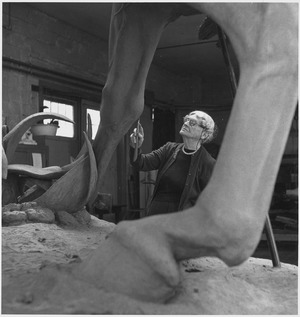
Anna married Archer Milton Huntington on her birthday, March 10, 1923. Together, they started Brookgreen Gardens in South Carolina. This place was once a large farm. Today, it is a famous sculpture garden and wildlife preserve.
Anna Hyatt Huntington was a member of important art groups like the National Academy of Design. She and her husband were very generous. They helped create fourteen museums and four wildlife preserves. They also gave land for the Collis P. Huntington State Park in Redding, Connecticut, where they lived. This park is about 800 acres (3.2 km²) big.
Anna Vaughn Hyatt Huntington passed away on October 4, 1973, in Redding, Connecticut. She is buried in Woodlawn Cemetery in The Bronx, New York City.
Anna Huntington's Legacy
Anna Hyatt Huntington's important papers are kept at Syracuse University and the Archives of American Art.
The Metropolitan Museum of Art sees Huntington as one of the most important women sculptors in the United States. She created many large statues for public places.
She was also the aunt of the art historian A. Hyatt Mayor.
Famous Animal and Equestrian Statues
Anna Hyatt Huntington made many animal sculptures. These included life-sized figures and smaller ones. Her art is in museums and collections all over the United States. You can see her work in many places in New York, like Columbia University, the Metropolitan Museum of Art, and the Bronx Zoo.
In 1904, she worked with another artist, Abastenia St. Leger Eberle, to create Man and Bull. This sculpture was shown at the St. Louis Exposition.
Her husband, Archer Huntington, founded the Hispanic Society of America in 1904. Anna created many sculptures for its courtyard, including:
- A bronze statue of El Cid (1927), a famous Spanish hero. Copies of this statue are in Spain, San Francisco, San Diego, and Argentina.
- Four bronze statues of Castilian warriors around the El Cid statue.
- Bronze bases for flagpoles.
- A stone carving of Don Quixote, a character from a famous Spanish book.
- A stone carving of Boabdil, the last Moorish king of Spain.
Anna created two statues at the entrance to Collis P. Huntington State Park in Redding, Connecticut: Mother Bear and Cubs and Sculpture of Wolves. The Huntingtons gave this park to the state. Other statues by Anna greet visitors at schools and libraries in Redding. Fighting Stallions is at the elementary school, and A Tribute to the Workhorse is at the middle school.
Her famous Joan of Arc statue stands in Manhattan. It was made to celebrate 500 years since Joan of Arc's birth and to honor France during wartime. This statue made Anna famous around the world. Copies of it are in San Francisco, Quebec City (Canada), Blois (France), and Gloucester, Massachusetts.
Andrew Jackson, A Boy of The Waxhaws is a large bronze statue at Andrew Jackson State Park in South Carolina. It shows a young Andrew Jackson riding a farm horse. Anna made the horse look gentle, focusing the energy on young Jackson. School children helped raise money for the statue's base. This was one of Anna's last major works, finished after her 91st birthday in 1967.
The General Israel Putnam statue is at Putnam Memorial State Park in Redding, Connecticut. It remembers General Putnam's escape from the British in 1779.
Los Portadores de la Antorcha ("The Torch Bearers") is a large aluminum statue in Madrid, Spain. It was given to the people of Spain in 1955. It symbolizes passing knowledge from older generations to younger ones. Copies of this statue are in Bridgeport, Connecticut; Redding, Connecticut; the University of South Carolina; Stevens Institute of Technology in New Jersey; and the Chrysler Museum of Art in Virginia.
The statue of Sybil Ludington in Carmel, New York, remembers a 16-year-old girl. She is said to have ridden 40 miles at night in 1777 to warn local soldiers about British troops. Smaller versions of this statue are in Washington, D.C., Danbury, Connecticut, and Brookgreen Gardens.
A peaceful statue of Abraham Lincoln reading a book while sitting on a horse is in front of the Bethel Public Library in Bethel, Connecticut. Anna Huntington signed it in 1961. The same statue is also at Lincoln's New Salem State Historic Site in Illinois. Anna gave this statue to Illinois in 1964.
Conquering the Wild overlooks a lake at The Mariners' Museum Park in Newport News, Virginia.
Gallery
-
Joan of Arc, West Ninety-third Street, Manhattan
-
José Martí, Central Park, New York City
-
Fighting Stallions, 1950, aluminum, entrance to Brookgreen Gardens, Murrells Inlet, South Carolina
-
Los Portadores de la Antorcha ("The Torch-bearers"), cast bronze, Discovery Museum and Planetarium, Bridgeport, Connecticut
-
Mother Bear and Cubs, at Earthplace, Westport, Connecticut
-
Don Quixote, aluminum 1947, Brookgreen Gardens, Murrells Inlet, South Carolina
-
Sybil Ludington, 1961, Carmel, New York
-
El Cid Campeador, bronze 1923, the central sculpture at the entrance to the Hispanic Society of America, New York City
-
Cid Campeador, a monument to El Cid in Seville
-
Youth Conquering the Wild at The Mariners Museum in Newport News, Virginia
-
One of the Reaching Jaguar sculptures at The Mariners Museum in Newport News, Virginia
-
Equestrian statue of Israel Putnam at the entrance to Putnam Memorial State Park
See Also
 In Spanish: Anna Hyatt Huntington para niños
In Spanish: Anna Hyatt Huntington para niños
- Atalaya and Brookgreen Gardens, a National Historic Landmark site in South Carolina
- Berkshire Museum, Massachusetts


